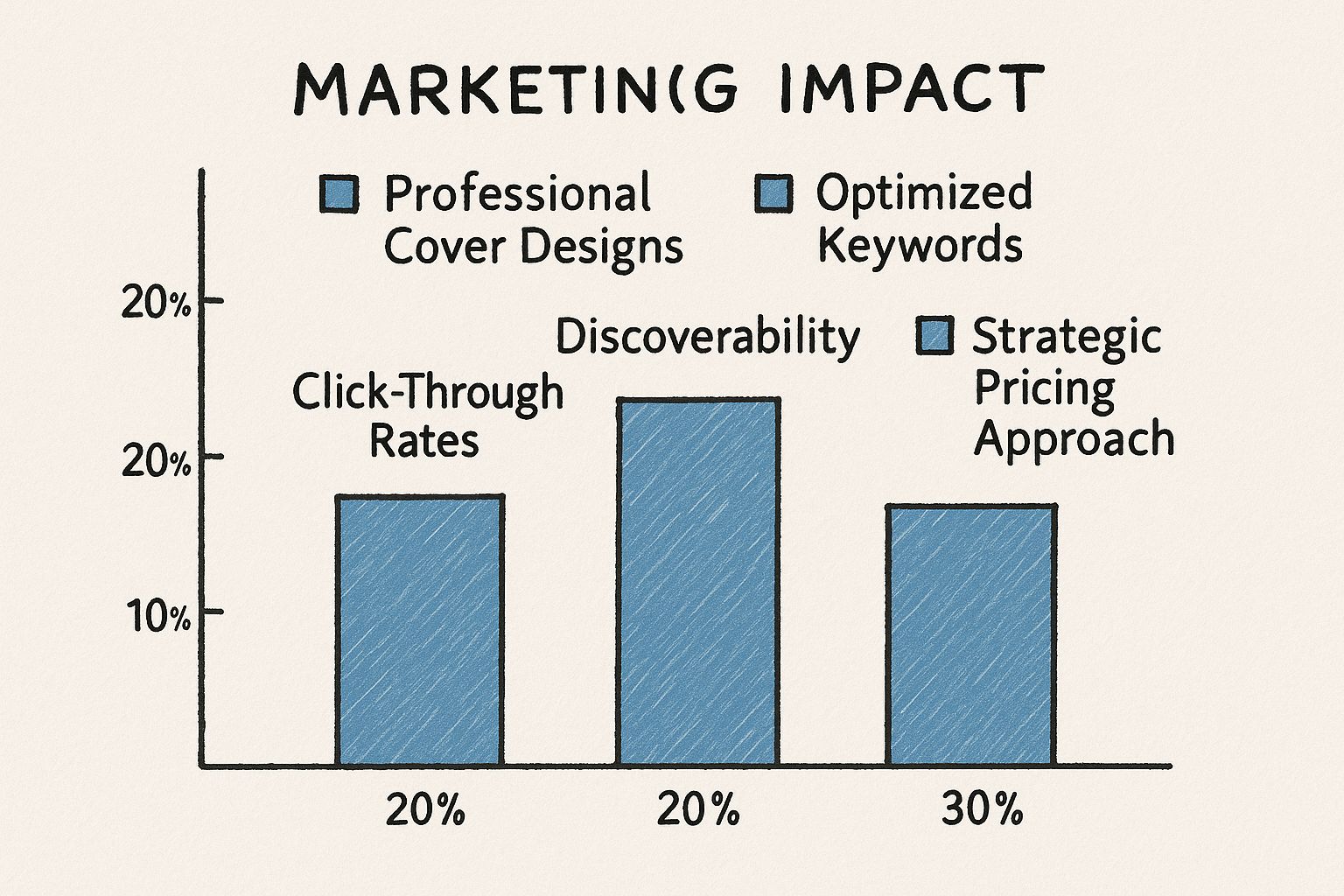How to Promote a Self-Published Book: Complete 2025 Guide

Quick Answer
How do you promote a self-published book effectively in 2025?
Successful self-published book promotion combines strategic pre-launch preparation (build email list, secure ARCs), Amazon optimization (keywords, categories, reviews), and multi-channel outreach (social media, influencers, email campaigns). The key differentiator for indie authors is taking full ownership of every promotional touchpoint while leveraging cost-effective tools and community-building tactics.
Top 3 self-publishing promotion priorities:
- Master Amazon's Ecosystem - Optimize metadata, use KDP Select strategically, and actively seek reviews
- Build Direct Reader Relationships - Email lists and reader communities drive sustainable sales
- Leverage Author Collaboration - Newsletter swaps, cross-promotions, and multi-author bundles amplify reach without big budgets
Understanding What You're Really Up Against
So, you've written a book. That's a massive accomplishment, and you should be genuinely proud. Before you dive headfirst into promotional tactics, let's have an honest chat about the world you're stepping into. Knowing how to promote a self-published book effectively starts with a realistic view of the competition and the market itself. It's no longer a niche corner of the publishing world; it's a full-blown stadium, and you've just been handed a jersey.
The reality is that self-publishing has seen explosive growth. To give you an idea, there's been a 264% increase in the number of self-published titles over the last five years. In 2023 alone, readers bought around 300 million self-published books, generating an estimated $1.25 billion in sales. You can find more details in this report on the state of self-publishing statistics. This isn't meant to scare you, but to prepare you. Hope isn't a strategy; understanding the landscape is.
To put this into perspective, let's look at how the market breaks down between traditional and self-published authors.
| Publishing Type | New Titles (2023) | Market Share | Growth Rate |
|---|---|---|---|
| Self-Published | 2.3 Million | 45% of Ebook Market | ~264% (5-year) |
| Traditional | ~500,000 | 55% of Ebook Market | ~-5% (5-year) |
Table Title: Self-Published vs Traditional Publishing Market Share Description: Comparison of market statistics showing the dramatic growth of self-publishing versus traditional publishing.
As you can see, while traditional publishing still holds a significant share, the sheer volume and growth in self-publishing are staggering. This means your book is entering a very crowded space.
The Myth of "If You Build It, They Will Come"
Many new authors operate under the false assumption that a great book will naturally find its audience. Unfortunately, that's rarely how it works. The hard truth is that most self-published books sell fewer than 100 copies in their lifetime. Why? Because discoverability is the single biggest hurdle you'll face. Your book isn’t just competing with other books in your genre; it’s competing with Netflix, TikTok, podcasts, and every other form of entertainment vying for your potential reader's attention.
The authors who break through this noise don't just get lucky. They are strategic. They accept the reality of market saturation and use it to their advantage by finding the gaps. They study their specific genre not just as a fan, but as a market researcher.
Identifying Your True Competition and Opportunity
Your competition isn't just the Stephen Kings or Brené Browns of the world. It’s the mid-list indie author who has consistently published three books a year in your niche, building a loyal following one reader at a time. It’s the author who has mastered Amazon ads or built an email list of 10,000 engaged fans. To succeed, you need to think like them.
Start by analyzing your specific category on Amazon. For instance, if you've written a "cozy paranormal mystery," search for that exact phrase and study the top 20 books that appear.
- What do their covers look like? Are there common color schemes or imagery?
- What keywords and tropes pop up in their blurbs?
- How are they priced? Are they running promotions?
- What do their negative reviews say? (This is often where opportunity hides).
Platforms like Amazon’s Kindle Direct Publishing (KDP) are the primary battlefield for most indie authors, so understanding this environment is non-negotiable.
Here is a look at the KDP dashboard, which will become your central hub for managing your books.

This interface is where you’ll upload your book, set your price, and run ads, making it ground zero for your promotional efforts. Successfully navigating it means treating your book not just as a piece of art, but as a product positioned to meet market demand.
Building Your Marketing Foundation From Scratch
Let's be honest, jumping straight into paid ads or a frantic social media blitz feels productive, right? It's a common mistake many authors make. But it's like building a house on quicksand; all that effort, time, and money will sink without a solid plan. The most successful strategies for how to promote a self-published book start with one crucial question: who is this book really for? The answer is never "everyone."
Defining Your Ideal Reader Avatar
Your ideal reader isn't a vague demographic like "women aged 30-50." They're a specific person with distinct tastes, habits, and reasons for reading. Creating an ideal reader avatar is a powerful exercise that changes how you approach marketing.
Think of it like this: if you wrote a historical romance novel, your avatar could be "Brenda." She's a 45-year-old librarian who unwinds with a glass of wine and loves the pure escapism of a well-researched period piece. She follows authors like Julia Quinn on Goodreads and is an active member of two historical fiction Facebook groups.
Knowing "Brenda" helps you:
- Find them where they are: You can target historical fiction groups on Facebook instead of wasting time on generic "book lover" pages.
- Speak their language: Your marketing copy can use phrases like "sweeping saga" and "period-accurate detail," which will catch Brenda's eye.
- Choose the right platforms: You know Brenda is more likely to be on Goodreads and Facebook than, say, TikTok.
Your Author Brand and Unique Value Proposition
Once you know who you're talking to, you need to be clear about what you're saying. Your author brand is the promise you make to your readers with every book. Are you the author who delivers laugh-out-loud romantic comedies, or the one who crafts meticulously researched thrillers that keep readers up all night? This identity needs to be authentic to you and consistent everywhere.
As you start laying this groundwork, it's a good idea to formalize it by developing a comprehensive social media marketing plan. This ensures your brand message is cohesive no matter where a reader discovers you.
Your book also needs a Unique Value Proposition (UVP). What makes your book stand out from the thousands of others in its genre? It’s more than just a clever plot.
- Is it your distinct writing voice?
- A fresh spin on a popular trope?
- A main character from an underrepresented background?
For instance, a great UVP for a fantasy novel could be: "It's The Lord of the Rings meets Peaky Blinders, set in a non-European-inspired world." This instantly tells a potential reader what to expect and what makes it different.
To help you prioritize your efforts, I've put together a table ranking some common marketing tactics based on author feedback and my own experience.
Most Effective Book Marketing Tactics Ranked
Effectiveness ratings of various marketing strategies based on author feedback and results
| Marketing Tactic | Effectiveness Score (1-5) | Average Cost | Time Investment |
|---|---|---|---|
| Email List Marketing | 5 | Low | Medium |
| BookBub Featured Deals | 5 | High | Low |
| Amazon Ads | 4 | Medium-High | High |
| Facebook Ads | 4 | Medium-High | High |
| Author Website/Blog | 4 | Low-Medium | High |
| Goodreads Giveaways | 3 | Low-Medium | Low |
| Social Media (Organic) | 3 | Low | High |
| Book Blogger Outreach | 3 | Low | Medium |
| Podcast Interviews | 2 | Low | Medium |
This table shows that while some high-impact tactics like a BookBub Featured Deal are costly, building your own email list is the most effective and affordable strategy in the long run. It requires time, but the direct connection with your readers is priceless.
Creating Your Core Promotional Assets
With your reader and brand clearly defined, you can start creating promotional materials that actually work. These are your foundational tools, and getting them right is absolutely essential for success. This isn't just theory; the data backs it up.

The numbers don't lie. A professional cover, smart keyword choices, and strategic pricing aren't just nice-to-haves; they directly translate into more visibility and sales.
This initial work might feel a bit slow and unglamorous, but it's the most important part of your marketing journey. Marketing is widely seen as the toughest part of self-publishing, with nearly 80% of authors calling it their biggest challenge. On average, indie authors spend around 8 hours a week and $700 a month on promotion. By building this solid foundation first, you ensure that your time and money are invested wisely, not wasted. For authors seeking more cost-effective options, our guide to affordable book marketing services compares professional services ranging from $35 to full-service agencies, many offering better value than the average monthly spend. If you want to dive deeper into the numbers, you can explore more ebook statistics here.
Mastering Digital Promotion That Actually Converts
When authors think about "digital promotion," it's easy to picture an endless loop of posting your book cover on social media and just hoping for the best. But truly effective promotion isn't about shouting into a digital void; it’s about making real connections where it counts. The aim isn't just to get noticed, but to earn trust. This mental shift is the foundation for learning how to promote a self-published book in a way that turns followers into actual readers.
This means you need to go beyond just random posts. It's about building a solid presence on the platforms where your ideal readers—like "Brenda," our example from earlier—are already hanging out. It’s about giving them something valuable, not just another sales pitch.
Building Your Most Powerful Asset: The Email List
If there’s one tool you absolutely need in your author toolkit, it's an email list. Social media algorithms can change in a heartbeat, but your email list is something you own and control. It's your direct line to the people who are most interested in your work. In fact, studies have shown that email marketing can have a massive return, often bringing in $36 for every $1 spent. That’s because these subscribers have literally given you permission to show up in their inbox; they want to hear from you.
So, how do you get people to sign up?
- Offer a compelling "reader magnet": Give away a piece of free, irresistible content in exchange for an email. This could be anything from a prequel short story or a deleted scene to a collection of character art or a helpful checklist if you write non-fiction.
- Put sign-up forms everywhere: Your author website, the back of your books, and your social media profiles should all have clear, simple links to join your newsletter.
- Talk to your subscribers: Don't just pop up when you have a book to sell. Share behind-the-scenes glimpses of your writing process, ask their opinion on a new character's name, or recommend other books you think they'd love. Make it a conversation.
Email marketing platforms like Mailchimp make managing all of this surprisingly simple, even if you don't consider yourself a tech expert.
Here's a peek at what a dashboard on a platform like Mailchimp looks like. It lets you see how your audience is growing and which emails are getting the most attention.

This data is gold. It tells you exactly what your readers find interesting, helping you fine-tune what you send them over time.
Strategic Content Creation Beyond Social Media
While social media is part of the puzzle, it shouldn't be your entire strategy. Your author website or blog is your digital home—a space that's 100% yours. It's also a great way to improve your search engine optimization (SEO), which helps new readers find you through Google. Try writing blog posts that tie into your book's themes. For instance, if you wrote a thriller about a cybersecurity expert, you could write posts like, "5 Common Security Mistakes People Make Online." This builds your credibility and draws in people who are already interested in your topic.
Podcasts are another fantastic channel. Being a guest on a podcast that your target readers listen to gives you 30-60 minutes of their undivided attention. It's an opportunity to build a connection that a quick social media post just can't replicate. You're not just an author; you're a real person with an interesting perspective.
Here’s how to make your content work harder for you:
- A single blog post can be sliced into five different social media updates.
- A podcast interview can be transcribed and turned into a blog post, with standout quotes becoming shareable graphics.
- A reader Q&A from your email list can become a YouTube video or a series of Instagram Stories.
This approach stops you from constantly reinventing the wheel and makes sure your main message gets out to more people on different platforms. For a deeper dive into these methods, you can also read our detailed guide on how to promote your book. The secret is to work smarter, not harder, by making every piece of content pull double or triple duty. This integrated approach is what helps authors build lasting careers instead of just burning out.
Cracking The Amazon Algorithm And Beyond
Thinking about how to promote a self-published book without a deep dive into Amazon is like planning a road trip without a map. Since the lion's share of ebook sales happens on this one platform, treating it as just another online store is a mistake you can't afford to make. To really succeed, you have to understand you’re not just selling to people; you're also selling to an algorithm. Your book’s product page is your digital storefront, and it needs to be set up to appeal to both human readers and Amazon’s powerful search engine.
It all boils down to your metadata—the bits of information that signal to the algorithm what your book is truly about. This isn't just about picking a general genre; it's about getting specific and strategic.
Optimizing Your Book for Discoverability
The first place to focus your energy is on your keywords and categories. Amazon gives you space for up to seven keywords, and this is prime digital real estate. Don't waste it with single, broad words like "mystery" or "romance." You have to think like a reader. What specific phrases would someone who loves your kind of book actually type into the search bar?
- Instead of "fantasy," you could try "epic fantasy with dragons and magic."
- Instead of "thriller," maybe use "psychological thriller with a twist ending."
A great way to find these is to look at the top-selling books in your niche. What keywords are they using? You can often spot clues in their subtitles and descriptions. Once you have your long-tail keywords, pair them with the right categories. Getting your book into a less-crowded sub-category can seriously boost your chances of earning a bestseller tag, which gives your visibility a massive push.
Beyond the basics, you should get familiar with Amazon’s own promotional tools. For example, A+ Content lets you add styled text and images to your book's product page, making it much more inviting than a plain wall of text. It's the difference between a simple menu and one with mouth-watering food photos.
Your control center for all this is the Kindle Direct Publishing (KDP) dashboard.
From here, you can tweak your keywords, polish your book description, and access Amazon’s marketing programs. This page should become your most-visited bookmark as a self-published author.
Smart Advertising and Reviews
With your page looking sharp, you can start thinking about Amazon Ads. It's a very effective platform, but going in without a strategy is a fast way to burn through your budget. I always recommend starting small, with a daily budget of just $5 to $10. Create a few different ads, maybe targeting the readers of specific authors who write books similar to yours. Your initial goal isn't profit; it's collecting data.
Are people clicking your ad but not buying the book? Your cover or blurb might be the problem. If you're not getting any clicks at all, your ad copy or targeting probably needs a rethink.
Of course, no amount of advertising can make up for a lack of reviews. Social proof is everything on Amazon. A simple but effective tactic is to include a polite, direct request for a review in the back matter of your book. Make it easy for them by including a direct link to the review page. When you get a negative review—and believe me, you will—don't engage. Take a breath, see if there's any useful feedback, and move on. A single one-star review won't kill your book's chances, but an author arguing in the comments definitely will.
Building Authentic Relationships That Drive Sales
Effective book promotion often comes down to a simple truth: people buy books from authors they know, like, and trust. While ads and algorithms have their place, the most durable strategy for learning how to promote a self-published book is to stop thinking like an advertiser and start acting like a community builder. This is all about making real connections with people who can spread the word and help you find the right readers.
The Power of Collaborative Marketing
Trying to do everything yourself is a surefire way to burn out. Instead, seek out win-win opportunities to team up with others in your niche. One of the most powerful tactics I've seen is the newsletter swap. This is where you and another author in a similar genre agree to feature each other's books in your email newsletters. It's a fantastic, zero-cost way to get your work in front of an audience that's already shown they enjoy your kind of story. The trick is to find authors at a similar point in their careers so the exchange feels fair and valuable for both sides.
To find potential partners, browse authors in your genre on Amazon, scout them out on social media, or join author communities on platforms like Facebook. When you reach out, keep it personal and professional.
- Mention their work: Start by saying you enjoyed one of their books (and actually mean it!). It shows you've done your homework.
- Be specific: Propose a clear idea. For instance, "I have a newsletter scheduled for next month that goes out to 2,000 sci-fi readers, and I think your new release would be a perfect fit. Would you be open to a swap?"
- Make it easy: Give them everything they need right away—your book cover, a short blurb, and purchase links.
This same idea works for cross-promotion on social media. You could co-host a giveaway or do an Instagram Live chat with another author. These collaborations introduce you to fresh audiences while creating great content for your existing followers.
Connecting with Reviewers and Influencers
Book bloggers, podcasters, and reviewers are the gatekeepers to passionate reading communities. Building relationships with them can open doors to massive exposure, but it demands a personal touch. Never blast out a generic, mass email. Instead, do your research. Find a podcast that has featured authors like you, listen to a couple of episodes, and then write a pitch that proves you understand their audience and content.
Getting reviews from your own readers is just as important. A simple, polite request in the back matter of your book can make a world of difference. You could also send a follow-up email to your newsletter subscribers a few weeks after a new release, asking them to share their thoughts. To make your outreach more effective, you can find inspiration from proven 7 Testimonial Request Email Templates That Work that are designed to get responses.
Nurturing Your Reader Community
Your connection with a reader shouldn't stop after they've turned the last page. Turning one-time buyers into loyal fans is how you build a long-term career. Platforms like Goodreads are perfect for engaging directly with readers who are actively talking about your books.

This screenshot shows an author’s Goodreads page, a central hub for reader feedback and interaction, which is key for community building. Participating in Q&A sessions, responding to comments, and thanking readers for their reviews are small actions that build tremendous goodwill. These interactions make readers feel seen and appreciated, turning them into advocates who will eagerly wait for and promote your next book. It's this long-game approach to relationship building—with fellow authors, influencers, and your own readers—that truly powers sustainable sales.
Advanced Tactics That Separate Success Stories From Statistics
Once you've got the promotional basics down, it's time to shift gears from simply selling a book to building a genuine, long-term career as an author. This is where the real magic happens. The reality of self-publishing is that sales can vary dramatically. Many authors sell fewer than 100 copies in a book's lifetime, a tough pill to swallow in such a competitive market.
But then you have incredible breakouts like Andy Weir’s The Martian, which started as a self-published work. The difference often comes down to creative, advanced strategies that build on one another over time. If you're curious about the numbers, you can delve into more self-publishing sales statistics to see the full landscape.
Orchestrating a Buzz-Worthy Launch
A great book launch isn’t a single-day event. It’s a carefully planned campaign that kicks off weeks, or even months, beforehand. Don't think of it as a firework—bright for a moment and then gone. Instead, picture it as a bonfire you build carefully and keep stoking to generate lasting heat. The aim is to create a wave of excitement that propels your book through its critical first few weeks.
A powerful launch layers several activities to maximize impact:
- Virtual Book Tour: Don't just cross your fingers for reviews. Actively team up with book bloggers, podcasters, and Bookstagrammers for scheduled features during your launch week. This creates a concentrated burst of third-party validation when it matters most.
- Reader Challenges: Get your current audience involved with a challenge tied to your book's theme. If you wrote a fantasy novel, you could host a "map-making challenge." For a self-help book, try a "7-day habit challenge." This builds a sense of community and sparks user-generated content around your release.
- Tiered Pre-order Incentives: Move beyond a simple pre-order campaign. Offer layered bonuses to create urgency. For example, everyone who pre-orders gets a related short story, but the first 100 people also receive a signed bookplate or exclusive digital art.
Designing Compelling Visual & Narrative Hooks
In a sea of books, the way your book looks and the story about the book are just as vital as the story inside. A sharp book trailer can be a game-changer. You don't need a massive budget; a well-edited 60-second video with animated text, your book cover, and the right music can easily stop someone from scrolling past.
Tools like Canva have made creating professional marketing materials accessible for everyone, no design degree required.
With platforms like this, you can put together everything from a book trailer to shareable quote graphics for social media. The secret is to weave storytelling into your marketing. Don't just say, "Buy my book." Instead, share the why behind it—a fascinating bit of research you uncovered or a personal experience that inspired a character. These narrative hooks forge an emotional connection that a standard ad just can't match. For a comprehensive toolkit that includes optimized marketing copy, social media content, and ad templates, check out our affordable book marketing services designed for indie authors.
Expanding Your Authorial Universe
The most successful authors know that a book isn't just a one-off product; it's the foundation of an intellectual property. Start thinking about how you can create multiple income streams from your work. This could mean exploring audiobook rights, looking into translation for global markets, or even creating merchandise for your most dedicated fans.
Even a setback, like a publication delay, can be turned into an opportunity. Use it to host a "sneak peek" chapter reveal to keep your readers engaged. By thinking beyond a single book sale, you're not just promoting a product—you're laying the groundwork for a sustainable and profitable career as an author.
Your Roadmap to Sustainable Author Success
Promoting a book can feel like you're trying to sprint a marathon. But building a lasting career as an author isn't about doing everything perfectly right away—it's about taking consistent, smart actions over the long haul. The real secret to learning how to promote a self-published book without burning out is to ditch the "do it all at once" mindset. Instead, focus on creating a personal plan with realistic goals and manageable daily habits. This long-term perspective is what separates authors who build careers from those who publish a book and then fade away.
A huge piece of this sustainable strategy is checking in on your efforts and learning how to track content performance. This means you need to concentrate on the numbers that actually show progress, not just vanity metrics that give you a temporary ego boost.
Tracking What Truly Matters
It's so easy to get caught up in follower counts or page likes, but those numbers often don't translate directly into book sales. A better approach is to build a simple dashboard that tracks what really moves the needle. You want to keep an eye on metrics that signal genuine reader interest and a desire to buy your book.
Here’s a simple table you can adapt to keep yourself focused:
| Key Metric | What It Tells You | How to Track It | Weekly Goal Example |
|---|---|---|---|
| Email Sign-ups | Your audience wants to hear from you directly. | Your email service provider's analytics dashboard. | 20 new subscribers |
| Ad Click-Through Rate (CTR) | Your ad's message and targeting are connecting. | Your Amazon or Facebook Ads dashboard. | Maintain a CTR above 0.5% |
| Review Count | Your book is building social proof and credibility. | Your book’s product page on Amazon or Goodreads. | 2 new reviews |
| Website Page Views | Readers are actively looking for more information about you. | Google Analytics on your author website. | 100+ unique visitors |
This kind of specific tracking helps you make adjustments based on real data. If your ad's CTR is lagging, it’s a clear sign to experiment with new ad copy or a different cover image. If your website traffic is growing, you know your social media or SEO work is paying off.
Building Momentum for the Long Haul
To keep your promotional energy up, you need to create systems that do the heavy lifting for you. For example, using a social media scheduler lets you prepare a whole week's worth of content in just a couple of hours. This frees up your mental energy so you can get back to writing.
Take a look at a tool like Hootsuite, which helps authors plan and automate their social media posts for consistent engagement.
This shows how you can manage several platforms from one spot, keeping a steady flow of content going out without being chained to your phone all day. The big takeaway here is that consistency comes from using smart tools, not just from raw willpower.
Ultimately, you need a marketing plan that supports your entire career, not just a single book launch.
- Plan future releases: Start dropping hints and building excitement for your next book while you're still promoting your current one.
- Stay motivated: Celebrate the small but meaningful victories, like getting a heartfelt email from a reader or hitting your weekly review goal.
- Manage expectations: Slow periods are completely normal in an author's career. The objective is progress over time, not instant perfection.
By turning these actions into habits, you create a flywheel effect. Each small success builds on the last, helping you grow your readership steadily and turn your passion for writing into a sustainable career.
Ready to stop guessing and start promoting with confidence? ManuscriptReport's comprehensive analysis service turns your manuscript into a complete promotional toolkit in minutes—extracting optimized book descriptions, targeted keywords, social media content, and ad copy directly from your story. Spend less time on marketing and more time writing your next book.
Related Articles

The Ultimate Affordable Book Launch Checklist: 9 Essential Steps for 2025
Complete affordable book launch checklist for 2025. Follow 9 proven steps—from budget planning to post-launch—for indie and self-published authors. Launch successfully for under $500.

How to Write Viral Book Hooks: 10 Proven Strategies for Social Media Success
Master the art of viral book hooks with 10 proven strategies, platform-specific tactics, and templates that grab attention on BookTok, Instagram, and beyond.

7 Must-Have AI Writing Tools for Authors
Discover essential AI writing tools for authors to boost creativity and streamline marketing. Learn actionable tips and explore solutions like ManuscriptReport.com.